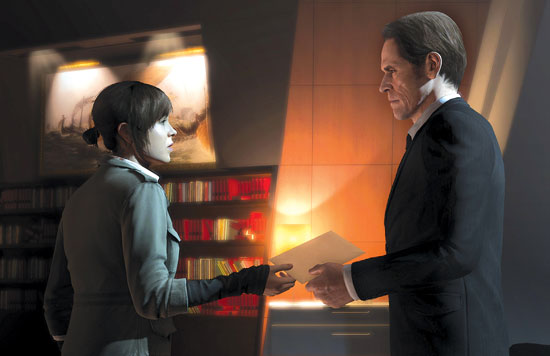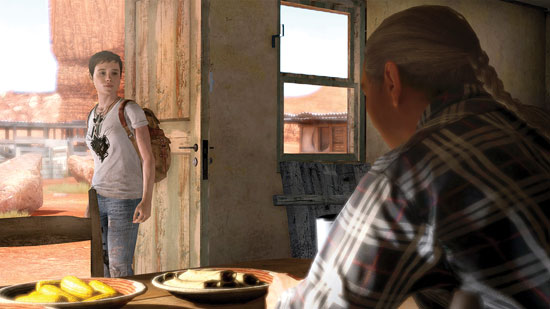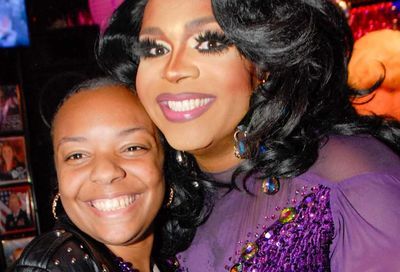Review – Beyond: Two Souls
''Beyond'' isn't much of a game, but as an experience, it has few peers. It's as close as we've gotten to an interactive film.

I can’t quite decide if Beyond: Two Souls is a masterpiece or a train wreck. One of the PS3’s swansongs, it and a handful of other exclusives represent the finale of seven years of gaming on the console. There is no doubt that, at least technologically, Beyond is an astonishing achievement — but it’s when considering it as a game, not a piece of art or technical accomplishment, that it starts to trip over itself. This is due to Beyond‘s tendency to take the basic concept of what a game is and stretch it to wafer-thin proportions. It isn’t so much a game, as a film you are an active participant in. As a result, it manages to simultaneously be one of the most engrossing and one of the most passive games I’ve ever played. Confused? Me too.
Beyond: Two Souls is the brainchild of Quantic Dream, led by the enigmatic and outspoken David Cage. Founded in 1997, Quantic Dream has made just four games since its inception, including Beyond. Cage uses his games to tell deep, engrossing stories. Heavy Rain was a technological marvel when it launched in 2008. Featuring a unique control scheme, advanced motion capture, nuanced voice acting and a story that played from the viewpoint of four player-controlled protagonists, it remains one of my favorite games of all time. Some critics lambasted the gameplay, which offered less control to the player in favor of giving them deeper narrative, but I loved it.
Beyond takes the core features of Heavy Rain and further dilutes the gaming aspects. It follows the story of Jodie Holmes — impeccably portrayed by Oscar-nominated Ellen Page — over a 15-year period. It’s a nonlinear narrative, jumping back and forth between different moments in Jodie’s life, with each scenario its own self-contained set piece that reveals another aspect to her character. Jodie has been connected to an invisible entity, known as Aiden, since birth — able to communicate with him and control him to varying degrees. Aiden can fully interact with the world around him, but only Jodie knows where he is or what he’s doing. As the game is played, it’s revealed that, as a child, when her connection with Aiden became dangerous for her parents, she was taken to the United States Department of Paranormal Activity. Here, she was raised and looked after by researcher Nathan Dawkins (Oscar-nominee Willem Dafoe), who tried to give Jodie as normal an upbringing as possible, while simultaneously trying to understand her connection with Aiden.
Jodie is later recruited by the CIA, which is interested in using her and Aiden’s connection in international espionage. After a botched mission, Jodie becomes disillusioned with her life as an agent and flees as a fugitive. The remainder of the story follows her attempts to avoid capture, piece together her life, and better understand her connection with Aiden. I’m deliberately trying to avoid spoiling the plot, hence the vague nature of this summary. I do so because the story that Beyond: Two Souls tells is nothing short of incredible. The nonlinear narrative can be confusing at times, relying on the player to remember every detail of the various locations and stages of Jodie’s life as the story plots its course. Forget leaving the game and returning to it after a while — the narrative demands that you give it your full, undivided attention from start to finish.
The story blends so many genres and concepts together, it can be overwhelming — one moment you’re playing a bombastic adventure game, the next you’re struggling to survive both physically and emotionally. The pace constantly jumps between high-octane and a slow crawl, but it never gets tiring because the story it’s telling is just so damn interesting. Jodie’s life is one of pain, loss and abandonment. She is alone, save for Aiden, and the player forms a deep bond with her over the course of the game. Other characters come and go between scenarios, but Jodie’s struggles, both literal and internal, are the core of the game and the main draw to play through its numerous scenes as you try to reach the conclusion of her tale. All of this is fully realized in the brilliant acting of Ellen Page, who displays a nuance and subtlety in her portrayal of Jodie so engrossing, so believable, that one feels another actress would have been simply overwhelmed by the demands of the part. Transitioning effortlessly between hardened CIA agent, damaged homeless youth, exhausted desert wanderer and fragile teen — among many other personas — Page gives us every reason we need to empathize with Jodie, to care for her, to try our hardest to ensure that we see her story through to the very end. All of this is enabled by Quantic’s groundbreaking work in motion capture.
Quantic Dream utilized full body motion capture for every scene of Beyond, giving its characters fluid natural movements as they navigate environments and act through cutscenes. Facial animations in particular, are astonishing. Eyes glint, sweat shines, pores are visible and wrinkles crease as the characters move and talk — Quantic’s attention to detail pays off, as Beyond offers some of the most realistic acting I’ve ever seen by characters in a game. It helps that Jodie, Nathan, et al resemble their real-life counterparts. Knowing Page and Dafoe, and seeing their characters look so much like them adds greater depth and satisfaction to cutscenes and gameplay. Watching Jodie cry and knowing that what you’re seeing is Page’s performance in the Quantic studio adds an extra dose of satisfaction to every emotional scene — and by God there are a lot of them.
Environments, too, are beautifully polished. Quantic is wringing every last pixel from the PS3 with Beyond, utilizing lighting, textures and wonderful set design to ensure that each location feels lived-in, looks realistic and pulls you further into the story. From offices to deserts, snow-coated cityscapes to rain-soaked forests, entity-filled basements to sun-soaked Somalia, Beyond‘s environments are a secondary character. They help tie the narrative together — returning to a familiar environment removes the worry of having to learn and memorize yet another aspect of Jodie’s story, but similarly, exploring a new one is a constant delight as you marvel at the detail in Quantic’s work. There are graphical issues — screen tearing and the occasional stutter during dense scenes — but for the most part, Beyond is a commendable example of the power of Sony’s seven-year-old console. It looks gorgeous.
The cream on Beyond‘s narrative cake is the sound. From background details — computers humming and clicking in offices, wind whipping up sand and sheep bleating in the distance in the desert, supernatural monsters crashing through walls and knocking over furniture, children laughing and shouting as they throw snowballs outside Jodie’s childhood home — to the Oscar-worthy voice-acting by every member of the cast, the sound lifts the experience of playing Beyond to another level. I can’t compliment enough the performances of the main cast. Forget any notion that actors would be willing to let their high standards drop for a video game —Beyond features better acting than many of the movies that launched in 2013. Really, I wish Page could be nominated for another Oscar, so perfect is her performance as Jodie.
It’s beautiful, the story is complex but engrossing, it sounds great and Page is fantastic. So far so good — until you actually pick up the controller to play. Beyond is a game that feels almost indignant that it needs a player to tell its story. It’s not a difficult game to play, utilizing just a few buttons and the analogue sticks, but its control scheme and implementation are a continuous source of frustration. Jodie interacts with the world through floating prompts — if you want to examine something, or pick up an item, the game will float the appropriate button icon over the object when you are within its vicinity. You navigate through this world with the analogue sticks. If you’re just wandering around Beyond‘s set pieces, it’s a rewarding experience — much like Heavy Rainwas, but with a simplified system for moving Jodie around the environment. This all changes when it comes to fast-paced situations, though. And don’t even get me started on controlling Aiden.

Every now and then, Jodie will be forced to engage in combat. Why, I don’t know, so hideous is Quantic’s system. Every time Jodie engages with an enemy — throwing a punch, blocking a kick, evading an attempt to grab her — the game enters a Matrix-style slow-motion mode. Jodie will start to move in the appropriate direction for whatever is occurring — she’ll lean away from a punch or move an arm up to block a kick, and the player must flick the right analogue stick to match Jodie’s movements, essentially removing them from directly influencing the action. Whatever Jodie wants to do, you have to match the action. It sounds simple, but it’s never fully effective. Often times I’d see an action occurring and flick in the way I expected Jodie to react — she’s running toward a sofa, surely she’ll want to jump up over it, right? I flick up when the game slows down and Jodie starts to leap. She crashes into the sofa. I reset, try again, wait a little longer for Jodie to start to leap. She’s definitely moving up — I flick up, she crashes into the sofa again. Hair starts to get pulled from my head. It’s a hit-or-miss system, with Jodie’s movement never fully corresponding to the direction you’re expected to move the thumbstick.
Aiden is another constant irk. There’s nothing particularly wrong with his movement controls, they’re just awkward. Navigating him as you fly through the environment is never quite how you wish it would be — you want to face a particular way, it’ll take fidgeting around to get it just right. Similarly, engaging with objects or characters is initially simple, but prone to frustration. For instance, to push something out of the way, the player holds down a button to focus on the object and follows on-screen prompts to pull both thumbsticks down and then flick them back to center. Simple enough, but it’s not 100 percent accurate every time. Given the number of times you’ll use Aiden over the game, it can quickly become frustrating. I could go on and on about the number of frustrations I have with the games controls — quick-time events are another bugbear — but I won’t. It doesn’t matter.
If proof is needed that Beyond: Two Souls isn’t a game that you should really be approaching from a gameplay point of view, consider this: It’s possible to play the entire game using a tablet as your only input device. Quantic included this option to allow non-gamers to experience the story without having to worry about the barrier of not understanding the layout of the PS3’s controller. That should tell you all you need to know about the focus of Beyond.
Beyond is not a game. Rather, it’s as close as we’ve yet gotten to having an interactive film. When the control scheme got out of my way and just worked, following the narrative felt like watching an engrossing, emotional movie — albeit one I directly influenced with my actions. Characters can live or die based on player input, there are multiple choices available to the player that will impact later scenes and at every stage it’s possible to play through the game in a different way. That’s what Beyond is, that’s what it was made to do. If two people watch a film, they can react to it differently, but they’re having the same basic experience. The same can’t be said if those two people play Beyond.
Two scenes in particular stand out — and there are so many standout moments in Beyond‘s narrative it’s hard to choose. One takes place in an unnamed desert. We find Jodie walking along a road until she stumbles across a ranch run by a Navajo family. It’s a slow-burning scene that quickly introduces a sinister plot point before melting back into the mundane — Jodie helps the family with their ranch, tending to animals, trying to befriend the ranch owner’s sons, going for a horse ride. During these slower scenes, I drank in the stunning desert landscapes, the animations of the characters, the sand whipping up around my feet as I walked. Then, as the plot pace quickens, it transforms into an action-packed race to save the family’s ranch from an other-worldly spirit. It demonstrates Beyond‘s ability to blend multiple genres in just one scene. One moment I’m having an emotional discussion, the next I’m surrounded by a mile-high sandstorm and trying to exorcise a demon.
The next scene, arguably my favorite, follows a portion of Jodie’s life when she finds herself homeless. She collapses on a snow-covered street and Aiden helps a homeless man rescue her. The scene follows Jodie as she wakes up in and integrates into a small homeless community that live under a bridge. It’s here that Beyondoffers its most simple, yet emotionally devastating moment. (Stop here if you don’t want spoilers.) Jodie, realizing the desperation of her situation — homeless, freezing cold, hunted by the CIA — walks out of the small camp, which overlooks a nearby freeway. The camera pans around her and we watch as Jodie studies the cars below, snow falling, her breath visible in the air. Two options slowly appear on-screen: “Jump” and “Don’t jump.” I was floored. These options are time-sensitive, you have only a number of seconds to pick one. I sat, staring at Jodie’s broken body, ready to leap out into traffic. It was a desperate, lonely, heartbreaking thing to witness. I cared for Jodie, I had followed her tale, she was my protagonist, but watching her empty gaze as she looked at the cars my mind flickered. “Maybe she should jump.” Let me remind you: This is a character in a game. My actions have no consequence in reality, but in-game, they mean everything.



Sony Computer Entertainment
Quantic Dream
$59.99
Gamestop.com
Amazon.com
That’s what Beyond does best. Were this a film, watching a character stand on that ledge and contemplate suicide would mean much less. The action is scripted, we know she will either jump or not. With Jodie, we are in charge. We choose whether she jumps. That’s what Beyond is here to do. It’s a frustrating game that places story above gameplay, forces the player to actively disengage from trying to play it and almost wishes we weren’t included so that it could just be a film and tell its tale the way it wants to. But it’s a game, and that control — however limited or annoying — is what ultimately sways Beyond‘s needle from train wreck to masterpiece.
I cannot in good conscience recommend it as a game. As something to pick up and play, it’s terrible. But as anexperience, as something you sit down and devote hours of your life and all of your emotions to, it has few peers. Beyond has affected me in a way no other games have. It’s a bizarre, disjointed narrative, that sometimes favors its supernatural elements a little too much, but when it focuses on the emotion — and the powerful performance of Ellen Page — Beyond finds some kind of nirvana. It’s a 10-hour interactive film that will leave you drained. It’s an experiment in narrative taking precedent over gameplay. It’s an occasionally frustrating, constantly beautiful, intensely dramatic swansong for a console that has given us so many incredible experiences. As a piece of dramatic, interactive art, I can think of no better way to wave farewell to Sony’s console.
Support Metro Weekly’s Journalism
These are challenging times for news organizations. And yet it’s crucial we stay active and provide vital resources and information to both our local readers and the world. So won’t you please take a moment and consider supporting Metro Weekly with a membership? For as little as $5 a month, you can help ensure Metro Weekly magazine and MetroWeekly.com remain free, viable resources as we provide the best, most diverse, culturally-resonant LGBTQ coverage in both the D.C. region and around the world. Memberships come with exclusive perks and discounts, your own personal digital delivery of each week’s magazine (and an archive), access to our Member's Lounge when it launches this fall, and exclusive members-only items like Metro Weekly Membership Mugs and Tote Bags! Check out all our membership levels here and please join us today!




















